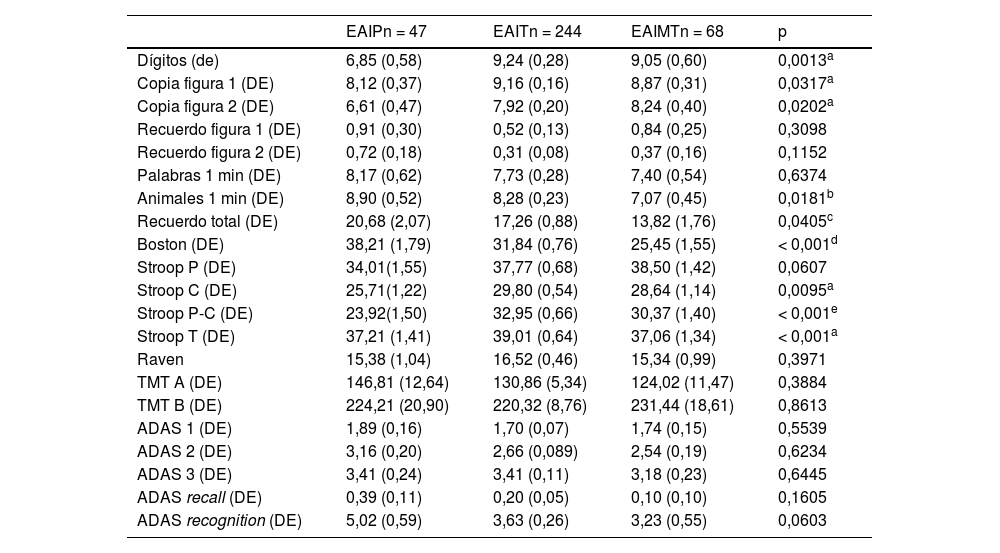La enfermedad de Alzheimer (EA) es la forma más común de demencia entre las personas mayores. La enfermedad de Alzheimer de inicio precoz (EAIP) se ha definido como una demencia debido a EA que se presenta antes de la edad arbitrariamente establecida de 65 años. De los pacientes con EA precoz, 50% debutan con síntomas atípicos y muestran alteraciones neuropsicológicas diferentes de aquellos pacientes que debutan más tarde. Estas atipias conllevan un retraso en el diagnóstico y en el inicio del tratamiento.
MétodosSeleccionamos retrospectivamente 359 pacientes con diagnóstico de probable demencia por EA. Subdividimos a los pacientes en tres grupos atendiendo a la edad de aparición de la enfermedad: EAIP, menores de 65 años; EA de inicio tardío (EAIT; entre 65 y 80); y EA de inicio muy tardío (EAIMT; definido como edad de inicio mayor de 80 años) y comparamos sus resultados neuropsicológicos.
ResultadosLos pacientes de EA con una edad de inicio más joven puntuaron peor en atención, función ejecutiva y habilidades visuoespaciales, mientras que los pacientes de mayor edad puntuaron peor en tareas de memoria y lenguaje. Los pacientes de inicio muy tardío se diferenciaron de los de inicio tardío en un mayor deterioro de la fluidez semántica y la denominación.
ConclusiónAunque la edad de 65 años podría corresponder a un punto de separación arbitrario entre la forma precoz y la forma de inicio más tardío de la EA, nuestro estudio demuestra que existen diferencias significativas entre estos grupos desde un punto de vista neuropsicológico. Sin embargo, estas diferencias parecen seguir una tendencia lineal con la edad, en lugar de representar cuadros clínicos fundamentalmente distintos.
Early-onset Alzheimer's disease (EOAD) has been defined as a dementia due to AD presenting before the arbitrarily established age of 65 (as opposed to late-onset Alzheimer's disease or LOAD). There is still little research about other age sub-groups, the use of so-called senile dementia has been banished, usually including it within the late-onset Alzheimer's dementia. To the extent of our knowledge, there are no studies comparing the neuropsychological features of very-late-onset patients with early and late-onset ones.
MethodsWe retrospectively selected 359 patients with a diagnosis of probable AD dementia. We subdivided patients into three groups attending to the age of onset of the disease: early-onset AD (EOAD; younger than 65 years old), late-onset AD (LOAD; between 65 and 80) and very-late-onset AD (VLOAD; defined here as onset age older than 80), and then we compared their neuropsychological results.
ResultsAD patients with a younger age at onset scored worse on attention, executive function and visuospatial skills, while older-onset patients scored worse in memory tasks and language. Patients with a very-late-onset differed from the late-onset ones in a greater impairment of semantic fluency and naming.
ConclusionAlthough the point of separation between EOAD and later-onset forms of EA at the age of 65 is an arbitrary one, our study shows that there are significant differences between these groups from a neuropsychological point of view. However, these differences do seem to follow a linear trend with age, rather than representing fundamentally distinct clinical pictures.










